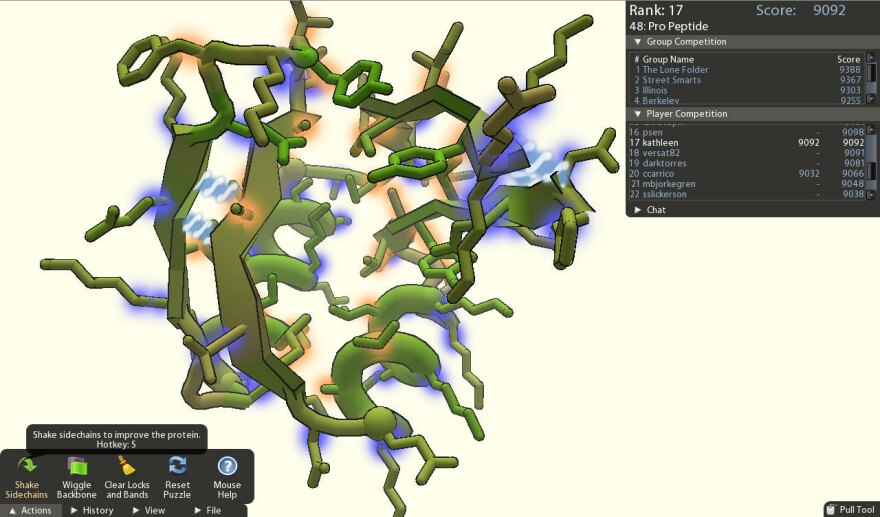People can get pretty addicted to computer games. By some estimates, residents of planet Earth spend 3 billion hours per week playing them. Now some scientists are hoping to make use of all that human capital and harness it for a good cause.
Right now I'm at the novice level of a game called EyeWire, trying to color in a nerve cell in a cartoon drawing of a slice of tissue. EyeWire is designed to solve a real science problem — it aims to chart the billions of nerve connections in the brain.
Anyone sitting in their living room can just fire up a Web browser and look at images of neurons, and help us figure out how they're connected.
"There's no way the professional scientists alone can analyze all of that," says Sebastian Seung, a neuroscientist at the Massachusetts Institute of Technology. "We need people to help us."
Seung thinks understanding all those connections is key to understanding how the brain works. He says you can imagine the brain as a huge jungle of entangled branches of neurons.
"We need an army of people to go out and explore that jungle," he says. "Scientists — professional scientists — are too few in number to do that all by themselves, so why not engage the public? It's a great adventure. What could be more exciting than exploring the brain? [It's] much more exciting than any artificial video game."
At least, Seung hopes that's what people will think. But before he tackles the human brain, Seung wants to explore a simpler collection of cells: the ones in the backs of the eyes of mice. So he and his colleagues created EyeWire, which looks at the neural connections in the eye. So far, about 35,000 people have registered with eyewire.org to play.
"Anyone sitting in their living room can just fire up a Web browser and look at images of neurons, and help us figure out how they're connected," he says.
The game sounds deceptively simple. Players get a virtual cube of material packed with a tangle of neurons to analyze.
"It looks like a three-dimensional coloring book," Seung says. "Your job is just to stay between the lines, which are the boundaries of a neuron, and follow the branch of a neuron through that cube."
But I can tell you it's not as easy as it sounds. The neurons are irregularly shaped and different sizes; predicting how they're connected takes lots of practice.
"It actually takes many hours of training to be able to color reliably between those lines," Seung says. Fortunately, you do get to practice, at the start of the game, on cubes where the neuronal branches have already been worked out. And only after you master those does the game offer you fresh, uncharted material.
"You have to learn something about neuroanatomy — what the structure of a neuron looks like at the micro scale — in order to do this reliably," Seung explains.
Now, you may be thinking what I was thinking when I heard Seung describing his game: Wouldn't a computer using artificial intelligence do a better job of coloring between the lines?

It turns out the answer is no. Human vision is better than machine vision for correctly picking out the patterns in this kind of task.
"One thing that humans are doing as they play this game — they're also teaching the artificial intelligence to become smarter," Seung says. I guess we humans are still good for something.
EyeWire is all about how well we humans see and do visual analysis. But there's another game, called Foldit, that takes advantage of something else we're really good at: thinking in 3-D.
The game was created at the Center for Game Science at the University of Washington. Zoran Popovic, who runs the place, says Foldit was designed to help solve a major problem in biology — how proteins fold.
That's an important issue. Misfolded proteins can lead to all kinds of diseases, from cystic fibrosis to mad cow disease.
Foldit has been a big success. Popovic says there are a half-million people registered to play the game, and that has made other scientists and inventors take seriously the idea of using games to solve scientific questions.
"I get a new proposal from people every week about a different potential scientific thing that we could do," Popovic says, adding that there are even more applications in engineering. "For example, one thing that people have a lot of trouble with is designing really compact silicon chips."
Although they're small, these chips have complicated 3-D structures. Designing them, Popovic says, is a bit of a dark art, and gamers might come up with better approaches.
One additional benefit to these games is they're open to everyone — you don't have to have an advanced degree to play.

Adrien Treuille, who was involved in the origins of Foldit and is now at Carnegie Mellon University, says there may be gifted people out there who have no idea they would be good at mapping neurons or designing silicon chips. And superstar gamers, he says, might have even more to contribute to science.
"These games have given us — really, for the first time in history — a way of identifying these people completely outside of the ordinary, academic food chain, which is [typically] very elitist and very difficult to get into," Treuille says.
Computer games may be a more populist way of drawing people into science and invention.
Copyright 2021 NPR. To see more, visit https://www.npr.org.




